A Greener Path: Embracing Sustainable Practices in Garden Design
I have always been passionate about living off the grid and embracing sustainable farming and gardening practices. For me, there is something incredibly satisfying about growing and tending to my own food, knowing that it is free from harmful chemicals and pesticides. As more and more people become conscious of the impact of their actions on the environment, sustainable gardening and farming have become increasingly popular. In this article, I want to share some tips and insights on how you can embrace sustainable practices in your garden design, whether you have a small urban plot or a large rural property.
1. Embracing Permaculture
One of the first steps in designing a sustainable garden is to embrace the principles of permaculture. This holistic approach to gardening and farming focuses on creating ecosystems that are self-sustaining and mimic the natural world. By working with nature rather than against it, permaculture garden designs can be incredibly productive and resilient. In my own garden, I have incorporated permaculture principles by creating diverse habitats for beneficial insects, using companion planting to improve crop yields, and capturing and storing rainwater for irrigation.
2. Choosing Native Plants
When designing a sustainable garden, it is important to choose plants that are native to your region. Native plants are well adapted to the local climate and soil conditions, making them low-maintenance and resilient. They also provide important habitat and food sources for local wildlife. By incorporating a variety of native plants into your garden design, you can create a beautiful and biodiverse landscape that supports the local ecosystem.
3. Building Healthy Soil
Healthy soil is the foundation of a successful garden, and sustainable gardeners understand the importance of building and maintaining fertile soil. Instead of relying on chemical fertilizers, I focus on building soil fertility through composting, mulching, and using organic fertilizers. By improving the health of the soil, you can promote strong, resilient plants that are better able to resist pests and diseases.
4. Conserving Water
Water conservation is a critical component of sustainable gardening, especially in areas prone to drought. I have implemented a variety of water-saving techniques in my garden, including drip irrigation, rainwater harvesting, and using mulch to reduce evaporation. By being mindful of water usage and implementing these practices, you can reduce your reliance on finite water resources and create a more sustainable garden.
5. Supporting Pollinators
Pollinators such as bees, butterflies, and other insects are essential for the health of our ecosystems and the productivity of our gardens. Sustainable garden designs prioritize creating habitat and food sources for pollinators. I have incorporated a variety of flowering plants, shrubs, and trees into my garden to attract and support pollinators. By creating a welcoming environment for these important creatures, you can help support the health of your garden and the broader ecosystem.
Pro Tips:
– Consider incorporating a variety of edible plants into your garden design, such as fruit trees, berries, and herbs. Not only will this provide you with a diverse and delicious harvest, but it will also contribute to the overall sustainability of your garden.
– Create wildlife-friendly habitats by leaving some areas of your garden wild and untended. These spaces can provide food, shelter, and nesting sites for birds, insects, and other wildlife.
In conclusion, sustainable garden design is not only good for the environment, but it can also be incredibly rewarding and productive. By embracing permaculture, choosing native plants, building healthy soil, conserving water, and supporting pollinators, you can create a beautiful and sustainable garden that benefits both you and the natural world around you. Whether you are new to gardening or have been at it for years, I encourage you to explore these sustainable practices and see how they can transform your garden into a greener and more vibrant space.



